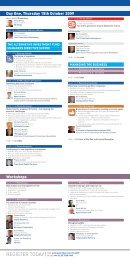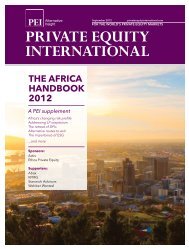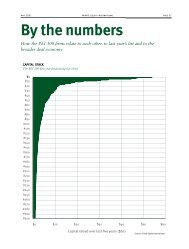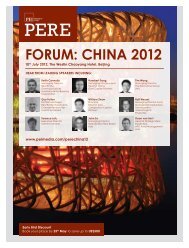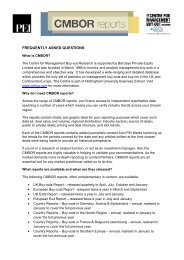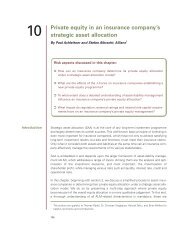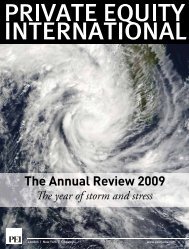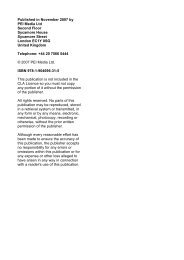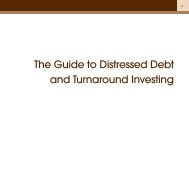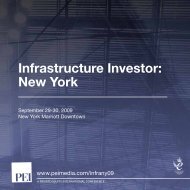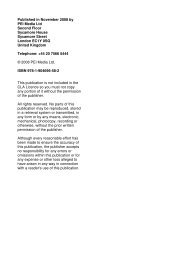THE ANNUAL REVIEW 2010 - PEI Media
THE ANNUAL REVIEW 2010 - PEI Media
THE ANNUAL REVIEW 2010 - PEI Media
You also want an ePaper? Increase the reach of your titles
YUMPU automatically turns print PDFs into web optimized ePapers that Google loves.
page 14 private equity annual review <strong>2010</strong><br />
s to r i e s o f t h e y e a r<br />
j a n | f e b | m a r | a p r | m a y | j u n e | j u ly | a u g | s e p | o c t | n o v | d e c<br />
s e c o n d a r y b u yo u t s<br />
Parcel passing<br />
Montagu was one of the most active firms on the sell-side of secondary buyouts,<br />
which dominated the <strong>2010</strong> deal landscape<br />
Passing the parcel: secondary deals flourished in <strong>2010</strong><br />
Montagu Private Equity in March sold medical technology business<br />
Sebia to Cinven in a deal understood to be worth roughly €800<br />
million. The transaction ended a long and hotly contested auction<br />
process, which ultimately earned Montagu a return of three times<br />
its invested capital.<br />
It also marked the third major asset sale by Monagu to a private<br />
equity buyer in as many months, having previously sold safety<br />
equipment manufacturer Survitec to Warburg Pincus for £280<br />
million and sausage casing manufacturer Kalle to Silverfleet Capital<br />
for €213 million.<br />
Montagu was not alone in selling assets to fellow GPs: in the first<br />
nine months of <strong>2010</strong> in the UK, for example, secondary buyouts<br />
accounted for nearly half (44 percent) of total buyout activity, with<br />
firms trading £5.5 billion-worth of investments between themselves,<br />
according to the Centre for Management Buy-out Research.<br />
Referred to as “pass-the-parcel” deals because they involve assets<br />
being passed from one financial sponsor to another, secondary<br />
buyouts have drawn criticism from limited partners and other market<br />
participants who argue the deals are often struck at high prices and<br />
provide little scope for further value creation. In some instances LPs<br />
find themselves indirectly owning the same asset, which has been<br />
passed between two of its GPs with all the associated transaction costs.<br />
Guy Hands, chief investment officer of Terra Firma, is one GP<br />
that has repeatedly criticised the practice. “Pass-the-parcel deals<br />
take substantial value away from LPs – I estimate approximately<br />
20 to 30 percent of equity each time,” Hands told delegates at a<br />
conference in November. “And if private equity increasingly goes this<br />
route, then it has only itself to blame when governments, unions,<br />
employees and eventually investors don’t support it.”<br />
The criticisms, however, may be unjustified, according to<br />
research produced in late <strong>2010</strong> by the Technische Universtät<br />
Mücnhen in conjunction with Munich-based fund of funds Golding<br />
Capital Partners. The study found that secondary buyouts have<br />
historically generated only marginally lower returns than primary<br />
buyouts. An analysis of 286 realised transactions from Golding’s deal<br />
database revealed that secondary buyouts had generated a median<br />
IRR of 31.9 percent, compared with 37.9 percent generated by<br />
primary investments.<br />
The difference in returns can largely be put down to the fact<br />
that secondary deals are on average larger in size than primary<br />
buyouts, and returns are inversely correlated to deal size, said<br />
the report. The study also concluded there is “little difference”<br />
in the levers for operational value creation between primary and<br />
secondary transactions. ■<br />
Goldman takes top rank in <strong>PEI</strong> 300<br />
The investment bank’s in-house group<br />
had the largest direct private equity<br />
investment programme in the world<br />
In Spring <strong>PEI</strong> revealed that private equity’s “silent<br />
giant”, Goldman Sachs’ Principal Investment Area,<br />
had catapulted to the No. 1 spot on the <strong>PEI</strong> 300,<br />
<strong>PEI</strong>’s annual proprietary ranking of private equity<br />
direct-investment programmes.<br />
The Wall Street behemoth raised nearly $55<br />
GS headquarters: towering<br />
above competition<br />
billion for direct private equity investment over<br />
the past five years, up from the $49 billion that<br />
earned Goldman the No. 2 spot on 2009’s list.<br />
The firm’s figures have remained high in part<br />
due to the impressive $13 billion it raised for its<br />
fifth mezzanine fund (a strategy that is counted<br />
in the <strong>PEI</strong> 300 methodology). And, unlike some<br />
other firms that raised large buyout funds in<br />
2007, Goldman has not downsized its $20.3<br />
billion GS Capital Partners VI, which is silently<br />
active all over the planet. ■



